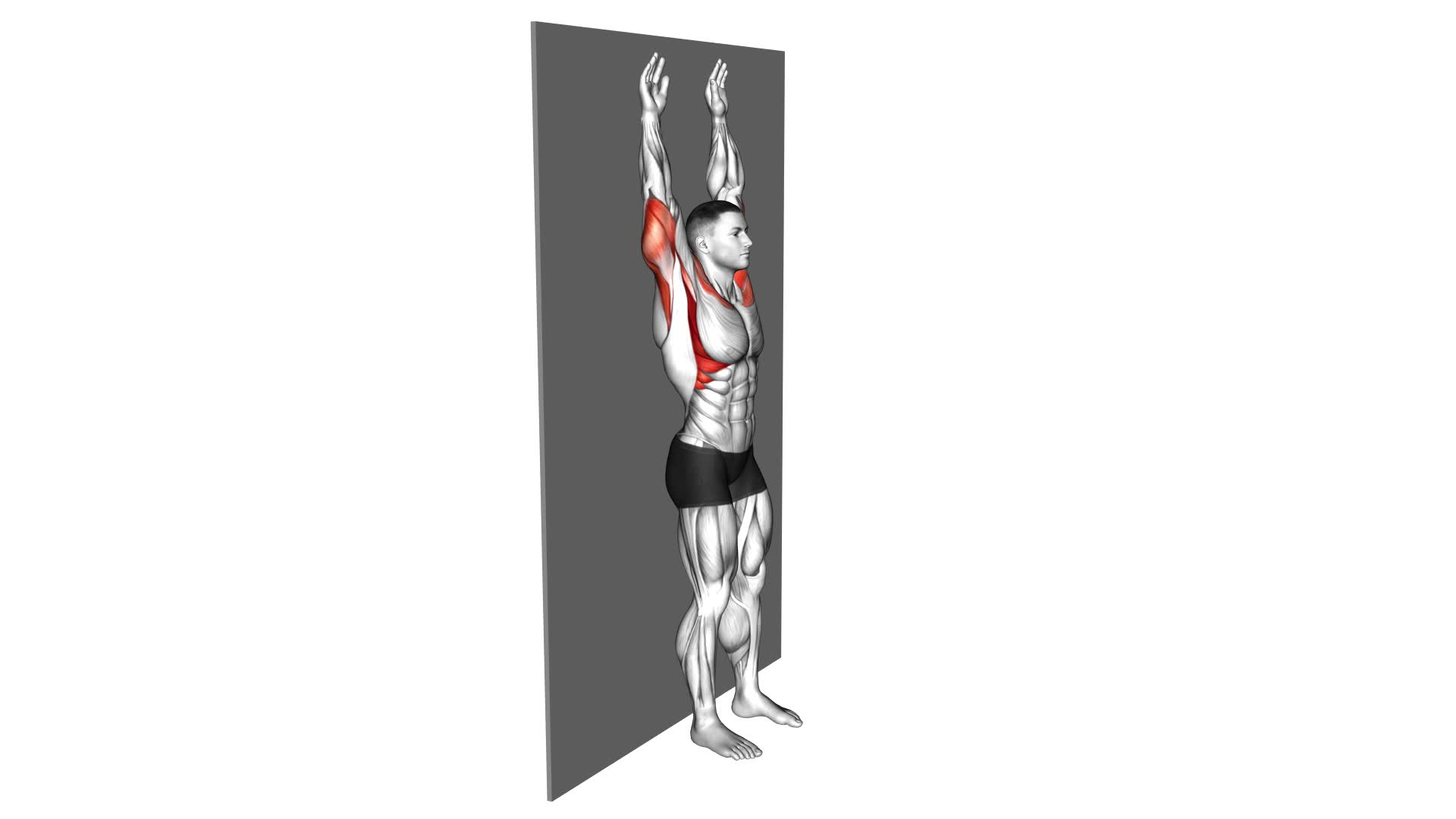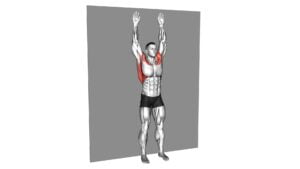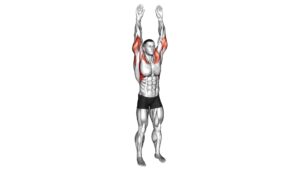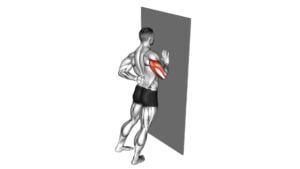Bodyweight Standing Military Press Wall Supported – Video Exercise Guide & Tips

Are you looking for an effective upper body workout that you can do anywhere? Look no further than the bodyweight standing military press.
Watch This Exercise Video
In this guide, we'll show you how to properly perform this exercise with the support of a wall. Not only will you strengthen your shoulders, arms, and core, but we'll also provide variations and tips to help you get the most out of your workout.
Get ready to press your way to a stronger and more defined upper body.
Key Takeaways
- Engaging core muscles and increasing stability
- Improving overall posture and body control
- Progressing and challenging yourself for muscle growth and strength development
- Preventing injuries with proper technique and form
Benefits of Bodyweight Standing Military Press
You'll experience numerous benefits when incorporating bodyweight standing military press into your workout routine. One of the key benefits is the importance of proper breathing. By maintaining a steady breath throughout the exercise, you engage your core muscles and increase stability. This not only helps you lift the weight more effectively but also improves your overall posture and body control.
Another benefit of bodyweight standing military press is the ability to progress and challenge yourself. As you become more comfortable with the exercise, you can gradually increase the weight or repetitions to continue pushing your limits. This progressive overload stimulates muscle growth and strength development, leading to better overall fitness.
Proper technique and form play a vital role in maximizing the benefits of bodyweight standing military press. By maintaining a neutral spine, engaging your core, and keeping your elbows tucked in, you ensure that the targeted muscles are effectively activated. This helps prevent injuries and ensures that you get the most out of each repetition.
Now that you understand the importance of proper breathing and how to progress in bodyweight standing military press, let's move on to the subsequent section where we'll discuss proper technique and form.
Proper Technique and Form
To ensure maximum effectiveness and prevent injuries, focus on maintaining proper technique and form during the bodyweight standing military press. Here are some tips to help you perform this exercise correctly:
- Stand with your feet shoulder-width apart and your back against a wall for support.
- Start with your arms extended and your palms facing forward at shoulder level.
- Engage your core and keep your spine straight throughout the movement.
- Slowly press your body up towards the ceiling by pushing through your palms, while maintaining control.
Common errors to avoid include:
- Arching your back excessively.
- Leaning too far forward or backward.
- Using momentum to lift the weight instead of relying on your upper body strength.
- Allowing your elbows to flare out to the sides.
To progress in this exercise, you can increase the number of repetitions or add weight. If you're finding it challenging, you can regress by using a lighter weight or performing the exercise seated.
By focusing on proper technique and form, you'll effectively target the muscles in your shoulders, upper back, and arms.
Now, let's explore the specific muscles targeted in this exercise.
Muscles Targeted in This Exercise
Let's talk about the muscles targeted in this exercise.
The standing military press primarily works your shoulders, specifically the deltoids. It also engages your triceps, upper back, and core muscles for stability and support.
Incorporating this exercise into your routine can help improve your upper body strength and posture.
Primary Muscle Groups
The exercise targets the muscles of your shoulders, known as the deltoids. Engaging these muscles through shoulder exercises offers numerous benefits, such as increased upper body strength and improved posture.
If you're looking for alternatives to the standing military press, consider the following exercises:
- Dumbbell shoulder press: Hold a dumbbell in each hand and press them overhead, focusing on the contraction of your deltoids.
- Push-ups: While primarily targeting the chest, push-ups also engage the shoulders and can be an effective way to strengthen them.
- Arnold press: This exercise involves rotating the dumbbells as you press them overhead, engaging the deltoids from different angles.
- Seated shoulder press: Sit on a bench or chair and press the dumbbells overhead. This variation allows for better stability and isolation of the shoulder muscles.
Now that you know the primary muscle groups targeted in this exercise, let's explore the secondary muscle activation.
Secondary Muscle Activation
Engage your triceps, core, and upper back muscles as secondary muscle groups during the bodyweight standing military press wall supported exercise. These muscles play a crucial role in maintaining stability and assisting the primary muscle groups during the exercise.
The triceps, located at the back of your upper arms, contribute to the extension of your elbows as you press the weight overhead.
Your core muscles, including the abdominals and obliques, help stabilize your spine and maintain proper posture throughout the movement.
Finally, your upper back muscles, such as the rhomboids and trapezius, work to retract and depress your shoulder blades, providing a stable base for the exercise.
Benefits of Exercise
To maximize the benefits of the bodyweight standing military press wall supported exercise, it's important to focus on targeting specific muscle groups. By incorporating this exercise into your regular routine, you can experience various benefits that contribute to your overall physical health and well-being.
Here are the key benefits of regular exercise and the importance of staying active:
- Increased muscle strength: The bodyweight standing military press wall supported exercise targets your shoulder muscles, helping to increase their strength and stability.
- Improved posture: This exercise also engages your core muscles, which play a vital role in maintaining good posture.
- Enhanced upper body endurance: Performing this exercise regularly can boost your upper body endurance, allowing you to perform daily activities with less fatigue.
- Increased calorie burn: Engaging multiple muscle groups simultaneously during this exercise can help you burn more calories, aiding in weight management.
Variations and Modifications
To effectively modify the bodyweight standing military press wall supported exercise, you should frequently adjust the position of your feet. This simple adjustment can provide different levels of difficulty and target various muscle groups.
For a more challenging variation, try widening your stance by placing your feet shoulder-width apart. This will engage your core and lower body muscles more intensely.
On the other hand, if you want to focus more on your upper body strength, bring your feet closer together, forming a narrow stance. This will put more emphasis on your shoulders and triceps.
Additionally, you can incorporate progression options and equipment alternatives to further modify the exercise. To increase the difficulty, you can add resistance by using dumbbells or resistance bands. This will challenge your muscles even more and promote greater strength gains.
Alternatively, if you don't have access to weights or resistance bands, you can use household items like water bottles or cans as makeshift weights.
By adjusting your feet position and incorporating progression options or equipment alternatives, you can customize the bodyweight standing military press wall supported exercise to suit your fitness level and goals.
Now, let's move on to some tips for maximizing your results and getting the most out of this exercise.
Tips for Maximal Results
For maximum results, focus on maintaining proper form and control throughout the bodyweight standing military press wall supported exercise. Here are some tips to help you achieve maximal results:
- Engage your core: Make sure to keep your abs tight and your back straight throughout the exercise. This will help you maintain stability and prevent any unnecessary strain on your lower back.
- Use a controlled tempo: Avoid rushing through the movement. Slowly lower the weight down to your shoulders and then press it back up. This will ensure that you're effectively targeting your shoulder muscles and maximizing your gains.
- Keep your elbows in: As you press the weight overhead, make sure to keep your elbows in line with your wrists. This will help you maintain proper alignment and prevent any undue stress on your shoulders.
- Breathe properly: Inhale as you lower the weight down and exhale as you press it back up. This will help you maintain proper breathing and provide you with the necessary oxygen to power through the exercise.
To see optimal results, it's important to perform the bodyweight standing military press wall supported exercise with proper form and control. Avoid common mistakes such as using momentum to lift the weight or arching your back excessively. Additionally, be mindful of your training frequency. Aim to perform this exercise 2-3 times per week, allowing for adequate rest and recovery between sessions.
Safety Precautions and Common Mistakes to Avoid
To ensure your safety and prevent common mistakes, it's important to be mindful of certain precautions when performing the bodyweight standing military press wall supported exercise. Proper form is crucial to avoid injury and maximize the effectiveness of this exercise.
One common mistake to avoid is using excessive weight. Start with a weight that you can comfortably lift and gradually increase as you build strength. Using too much weight can strain your muscles and lead to injury.
Another mistake isn't maintaining a stable core. Engage your core muscles by tightening your abs and glutes throughout the movement. This will help stabilize your body and prevent unnecessary strain on your back.
Proper shoulder positioning is also key. Keep your shoulder blades pulled back and down throughout the exercise. This will improve your posture and prevent shoulder impingement.
Additionally, avoid locking your elbows at the top of the movement. This can put excessive stress on the joints. Instead, maintain a slight bend in your elbows to protect your joints and maintain control.
Lastly, always warm up before performing the bodyweight standing military press wall supported exercise. This will increase blood flow to your muscles and reduce the risk of injury.
Frequently Asked Questions
How Many Reps and Sets Should I Do for the Bodyweight Standing Military Press?
To determine the number of reps and sets for the bodyweight standing military press, consider your fitness level and goals.
Start with 3 sets of 8-12 reps, focusing on proper form and control.
As you progress, increase the number of sets or reps.
For more challenge, try variations of the exercise without wall support, such as using dumbbells or resistance bands.
Remember to listen to your body and adjust accordingly.
Can I Do the Exercise Without a Wall for Support?
To do the bodyweight standing military press without a wall for support, you can try some alternative exercises or modifications.
Without the wall, it may be more challenging to maintain stability and balance. Consider using dumbbells or resistance bands instead to work your shoulders and arms.
Remember to start with lighter weights and focus on proper form. As you gain strength and confidence, you can gradually increase the resistance.
What Are the Potential Benefits of Incorporating the Bodyweight Standing Military Press Into My Workout Routine?
Incorporating the bodyweight standing military press into your workout routine can have several potential benefits.
This exercise targets your shoulders, arms, and core muscles, helping to increase strength and muscle definition. It also improves your posture and stability.
By using your own bodyweight, you can challenge yourself without the need for additional equipment. Additionally, there are variations and modifications available to suit different fitness levels and goals.
Remember to consult with a fitness professional to ensure proper form and technique.
Are There Any Specific Breathing Techniques I Should Follow During This Exercise?
To ensure proper form and maximize the benefits of the bodyweight standing military press, it's important to follow specific breathing techniques. When performing this exercise, exhale as you lift the weight overhead and inhale as you lower it back down.
This helps stabilize your core and maintain control throughout the movement. Remember to breathe consistently and avoid holding your breath, as it can increase pressure in your chest and reduce overall performance.
Can This Exercise Help With Improving Overall Shoulder Strength and Stability?
Yes, this exercise can definitely help improve your overall shoulder strength and stability.
By performing the Bodyweight Standing Military Press Wall Supported, you engage various muscles in your shoulders, helping to increase their strength.
This exercise also promotes shoulder mobility, allowing for better range of motion.
However, it's always beneficial to incorporate alternative shoulder exercises into your routine to target different muscle groups and avoid overuse injuries.
Conclusion
To maximize the benefits of the bodyweight standing military press, it's crucial to maintain proper technique and form. This exercise targets various muscles, including the shoulders, triceps, and core.
By incorporating variations and modifications, individuals can tailor the exercise to their fitness level. Remember to follow safety precautions and avoid common mistakes for optimal results.
With dedication and consistency, you can achieve your goals with this effective exercise.

Author
Years ago, the spark of my life’s passion ignited in my mind the moment I stepped into the local gym for the first time. The inaugural bead of perspiration, the initial endeavor, the very first surge of endorphins, and a sense of pride that washed over me post-workout marked the beginning of my deep-seated interest in strength sports, fitness, and sports nutrition. This very curiosity blossomed rapidly into a profound fascination, propelling me to earn a Master’s degree in Physical Education from the Academy of Physical Education in Krakow, followed by a Sports Manager diploma from the Jagiellonian University. My journey of growth led me to gain more specialized qualifications, such as being a certified personal trainer with a focus on sports dietetics, a lifeguard, and an instructor for wellness and corrective gymnastics. Theoretical knowledge paired seamlessly with practical experience, reinforcing my belief that the transformation of individuals under my guidance was also a reflection of my personal growth. This belief holds true even today. Each day, I strive to push the boundaries and explore new realms. These realms gently elevate me to greater heights. The unique combination of passion for my field and the continuous quest for growth fuels my drive to break new ground.



